The Southern Crab Nebula is a symbiotic nebula located approximately 10,700 light-years away in the southern constellation Centaurus (the Centaur). With an apparent magnitude of 14.20 and an apparent size of 0.083 arcminutes, it cannot be observed with amateur telescopes. The nebula is catalogued as Henize 2-104 (Hen 2-104) and WRAY 16-147.
The Southern Crab Nebula was named for its resemblance to the legs and claws of the crab. It has a much better-known counterpart in the Crab Nebula (Messier 1), a supernova remnant in the northern constellation Taurus. However, Henize 2-104 is not the same type of object as its brighter northern namesake. Unlike the progenitor star of M1, the central star of the Southern Crab has not yet reached the end of its life, and it is not massive enough to go out as a supernova.
The Southern Crab Nebula has the shape of an hourglass embedded in a larger hourglass. It has a diameter of around 6.5 light years. It bears a resemblance to several planetary nebulae with hourglass-shaped structures, including the Butterfly Nebula (NGC 6302) in the constellation Scorpius.
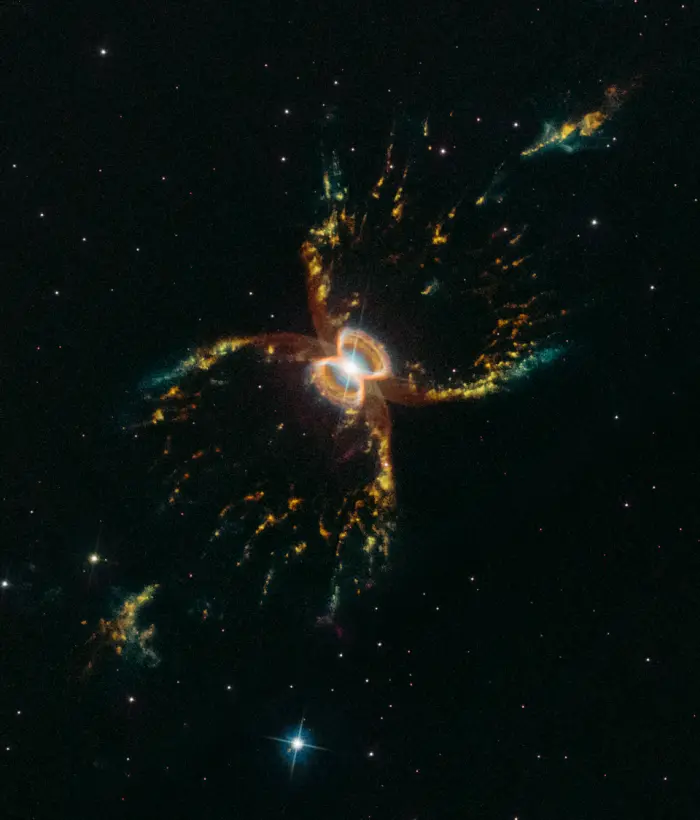
In celebration of the 29th anniversary of the launch of NASA’s Hubble Space Telescope, astronomers used Hubble to capture this festive, colorful look at the tentacled Southern Crab Nebula. The nebula, officially known as Hen 2-104, is located several thousand light-years from Earth. It appears to have two nested hourglass-shaped structures that were sculpted by a whirling pair of stars in a binary system. The duo consists of an aging red giant star and a burned-out star, a white dwarf. The red giant is shedding its outer layers. Some of this ejected material is attracted by the gravity of the companion white dwarf. The result is that both stars are embedded in a flat disk of gas stretching between them. This belt of material constricts the outflow of gas so that it only speeds away above and below the disk. The result is an hourglass-shaped nebula. Image credit: NASA, ESA, and STScI (PD)
The central star of the unusual southern nebula is a pulsating red giant – a Mira variable – that forms a symbiotic binary system with a white dwarf. The star system was resolved by the Hubble Space Telescope’s Wide Field and Planetary Camera 2 in 1999.
Mira variables are evolved red giants on the asymptotic giant branch (AGB) that have yet to expel their outer layers to form planetary nebulae. These are pulsating stars. As they expand and contract, their radii and temperatures change, causing changes in luminosity and visual brightness. Mira stars are rapidly losing mass and are often enveloped in clouds of dust. Thermal pulses cause even higher mass loss and can produce detached shells of expelled material around the stars.
The aging red giant star at the heart of the Southern Crab has a luminosity around 6,000 times that of the Sun.
The extended hourglass-shaped nebula around the central pair of stars was discovered by Schwarz et al in 1989. Upon discovery, the object would have been classified as a planetary nebula if the central star had not been found to be a long-period pulsating Mira two years earlier, in 1987.
The Southern Crab Nebula was produced by similar mechanisms – high mass loss rate and stellar winds – that are responsible for forming planetary nebulae and objects like the Homunculus Nebula around the luminous blue variable Eta Carinae. However, in the case of the Southern Crab Nebula, it is the white dwarf companion that is shaping and ionizing the clouds of material lost from the red giant star. The nebula’s kinetic energy and momentum are similar to those of planetary nebulae and considerably lower than those of protoplanetary nebulae.
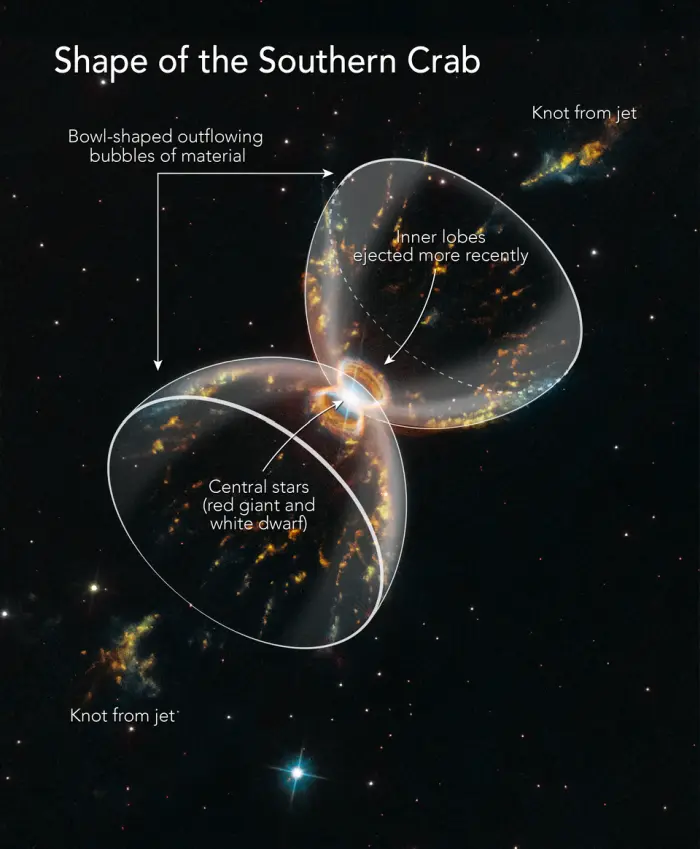
This diagram traces the hourglass structure formed by a pair of huge, bipolar gas bubbles ejected by a double star in the center of the Southern Crab Nebula. The gases are dispersed too thinly for the full shape of the hourglass to be photographed. Instead, the bubbles appear brightest at the edges, giving the illusion of crab leg structures. The stars are likely embedded inside a disk of material that constricts and directs the outflow of gas from the system. Credit: NASA, ESA, and A. Feild (STScI) (PD)
While some sources refer to the Southern Crab Nebula as a planetary nebula, the object is a mimic. It is commonly identified as a symbiotic outflow. Planetary nebulae are expanding shells of material expelled from evolved red giant stars, ionized by the intense ultraviolet radiation from the hot, exposed stellar core.
The Southern Crab Nebula, on the other hand, is the product of complex interactions between the two components in the central binary system. Like all evolved stars, the Mira-type red giant is losing mass through a strong stellar wind and a small fraction of that mass is accreted by the white dwarf companion. The accretion of mass sometimes causes thermonuclear outbursts on the surface of the white dwarf that last for several hundred years, causing the white dwarf to become a symbiotic nova. As the fast winds from the stellar remnant collide with the slower winds of the red giant star, they shape the circumbinary nebula.
The inner and outer lobes of the nebula are composed of material ejected at different stages of the evolutionary cycle of the central star. The two pairs of lobes are believed to be coeval.
The pairs of lobes indicate that there were two separate outbursts that occurred several thousand years apart. The first one produced the nebula’s outer lobes and the second, the inner lobes. The jets of material visible beyond the lobes are believed to have been produced in the older eruption and accelerated by the accretion disk around the white dwarf.
The Southern Crab Nebula is a frequent target for studies of a wide range of astrophysical processes, including mass accretion, transfer and outflow in symbiotic binary systems, photoionization, and the chemistry of dust and gas in systems composed of both cool and hot stars.
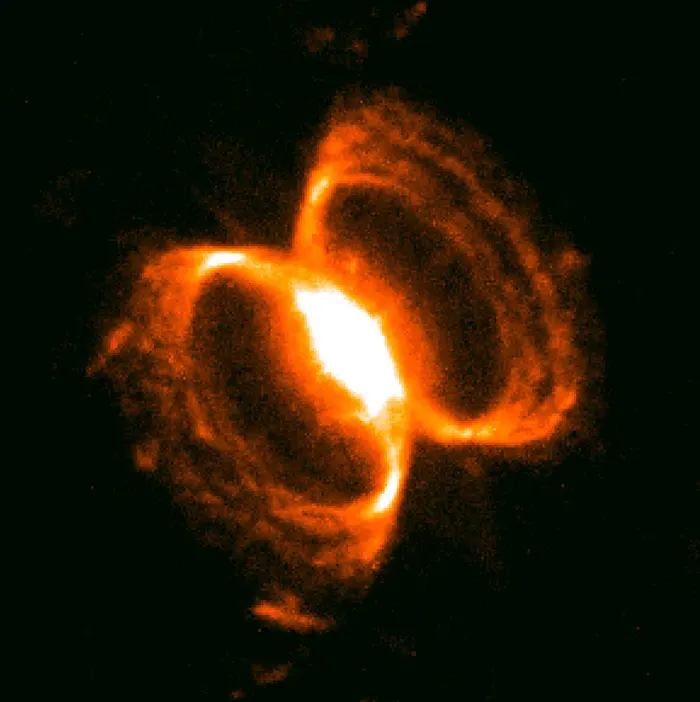
The center of the Southern Crab Nebula (He2-104), as observed by the Hubble Space Telescope in 1999. A tempestuous relationship between an unlikely pair of stars may have created an oddly shaped, gaseous nebula that resembles an hourglass nestled within an hourglass. This image shows the small nebula that is embedded in the centre of the larger one. Image credit: Romano Corradi, Instituto de Astrofisica de Canarias, Tenerife, Spain; Mario Livio, Space Telescope Science Institute, Baltimore, Md.; Ulisse Munari, Osservatorio Astronomico di Padova-Asiago, Italy; HugoSchwarz, Nordic Optical Telescope, Canarias, Spain; and NASA/ESA (PD)
In 2008, astronomers used images and spectroscopic data obtained with Earth-based and space telescopes to create a 3-D spatio-kinematical model of the Southern Crab Nebula. Observations with Hubble and the Very Large Telescope (VLT) led to the first spectroscopic detection of the central red giant. They allowed researchers to determine an expansion parallax distance of 3.3 ± 0.9 kiloparsecs for the nebula.
The team, led by M. Santander-García of the Instituto de Astrofísica de Canarias (IAC), found a density of 500 – 1,000 cm-3 in the inner lobes and 300 – 500 cm-3 in the outer lobes. This implies an unusually large ionized mass for Hen 2-104 of around one tenth of a solar mass.
Hubble captured the nebula once again with the Wide Field Camera 3 in 2019. The image was released to celebrate the 29th anniversary of the space telescope’s launch.
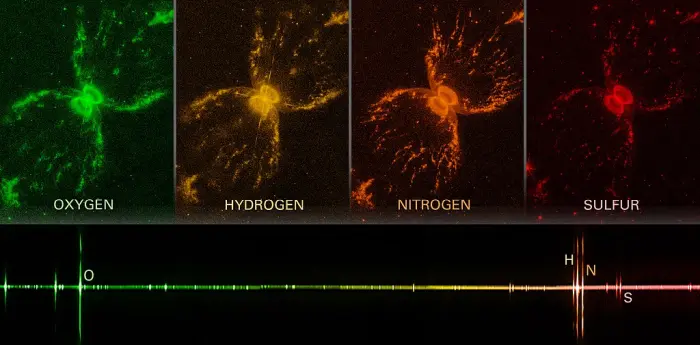
Dissecting the Southern Crab Nebula This diagram illustrates how Hubble Space Telescope spectral observations were used to study the chemical makeup of the Southern Crab Nebula. The hourglass-shaped nebula contains elements forged in the interior of its two aging central stars that were then expelled back into space. Energized by radiation from the pair of bright stars, each of these elements glows in specific colors (or wavelengths) of light. Hubble’s Space Telescope Imaging Spectrograph (STIS) divided the light from the nebula’s filaments to record the emission from hydrogen, sulfur, oxygen, and nitrogen. The combination of STIS spectroscopy and the image from Hubble’s Wide Field Camera 3 shows specifically which gases were detected and how they are distributed in the nebula. The STIS spectrum allows for a better understanding of the nature of the two stars at the nebula’s center. Credit: NASA, ESA, and J. DePasquale (STScI) (PD)
Facts
The Southern Crab Nebula was first catalogued by James David Wray in his doctoral thesis “A study of Hα-emission Objects in the Southern Milky Way” at Northwestern University in 1966. Wray’s PhD thesis was based on the photographic plates taken by American astronomer Karl Henize during his stay in South Africa from 1948 to 1951. Henize surveyed the southern sky for stars that showed emission lines of hydrogen. He listed the Southern Crab as Henize 2-104 in his second catalogue of southern planetary nebulae, Observations of Southern Planetary Nebulae (1967).
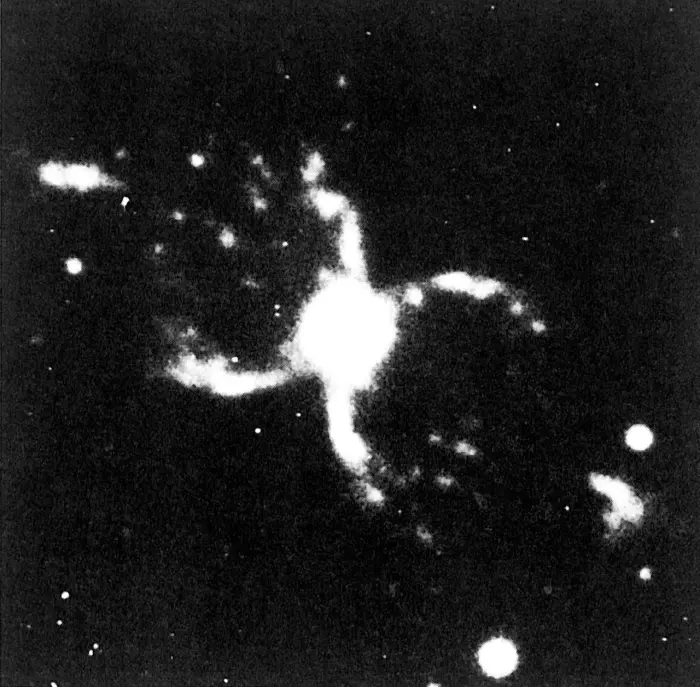
The “Southern Crab” Nebula (He2-104). This CCD image of the proto-planetary symbiotic star He2-104, also known as the “Southern Crab”, was obtained with the 2.2 metre telescope at La Silla by Hugo Schwarz and collaborators; the exposure time was 30 min. It shows the unusual object in the light of nitrogen ions ([N II] Å). The visual magnitude of the central part is 14.6. Credit: ESO (CC BY 4.0)
Location
The Southern Crab Nebula appears roughly halfway between Epsilon Centauri and the fainter Rho Lupi in the constellation Lupus (the Wolf). Epsilon Centauri is part of the constellation figure of Centaurus. It is the nearest second magnitude star to the Southern Pointers, Rigil Kentaurus and Hadar (Alpha and Beta Centauri). Rho Lupi appears close to Uridim (Alpha Lupi), the brightest star in Lupus.
Unlike the northern Crab Nebula, which is visible in binoculars, the Southern Crab Nebula is too faint and small to be spotted in backyard telescopes. At declination -51° 26’, it never rises for observers north of the latitude 38° N.
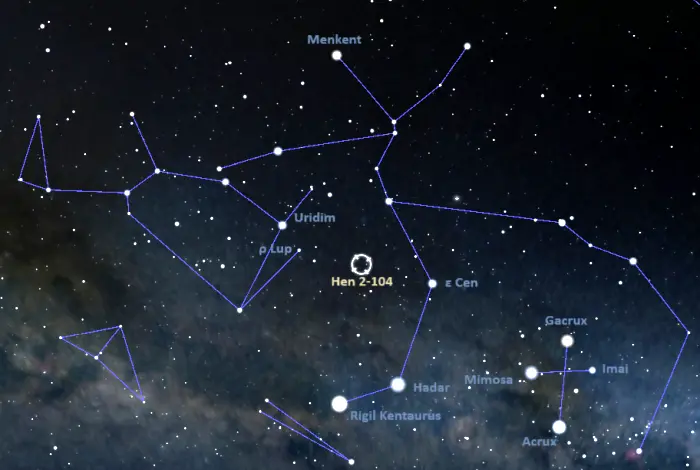
The location of the Southern Crab Nebula (Henize 2-104), image: Stellarium
Southern Crab Nebula – Henize 2-104
| Constellation | Centaurus |
| Object type | Symbiotic nebula |
| Right ascension | 14h 11m 52.0604355768s |
| Declination | −51° 26′ 24.187122024″ |
| Apparent magnitude | 14.20 |
| Apparent size | 0.083333336’ x 0.083333336’ |
| Diameter | 6.5 light-years |
| Distance | 10,700 light-years (3,300 parsecs) |
| Names and designations | Southern Crab Nebula, Henize 2-104, Hen 2-104, WRAY 16-147, ESO 221-31, PK 315+09 1, PN G315.4+09.4, V852 Centauri, V852 Cen, SCM 78, SS73 43, GSC2 S2321313350, IRAS 14085-5112, 2MASS J14115206-5126241, TIC 329892320, Gaia DR2 6089564718596906880, Gaia DR2 6089564718596906880 |